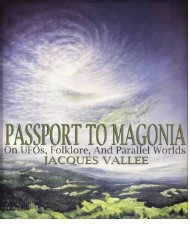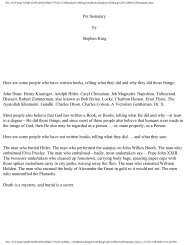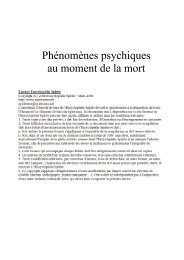extraordinary%20encounters
extraordinary%20encounters
extraordinary%20encounters
Create successful ePaper yourself
Turn your PDF publications into a flip-book with our unique Google optimized e-Paper software.
82 Dead extraterrestrials<br />
north Texas town. When the latter tale was revived<br />
in the late 1960s and early 1970s, hopeful<br />
investigators rushed to the scene, only to<br />
learn eventually that no such corpse or grave<br />
had ever existed outside the imagination of a<br />
turn-of-the-century prankster.<br />
Though it did not come to wider attention<br />
until many years later, a killing of a tiny humanoid<br />
reportedly took place in 1913 near<br />
Farmersville, Texas. Three young brothers<br />
were chopping cotton on their farm when<br />
they heard the family dogs barking and then<br />
howling. On investigating, the boys saw the<br />
dogs attacking a strange little man “no more<br />
than eighteen inches high and kind of a dark<br />
green color,” one witness, an old man, recalled<br />
in a 1978 interview. “His arms were hanging<br />
down just beside him, like they was growed<br />
down the side of him. He had on a kind of<br />
hat that reminded me of a Mexican hat. . . .<br />
Everything looked like a rubber suit including<br />
the hat.” The dogs tore him to pieces, leaving<br />
human-looking organs and blood on the<br />
ground. The peculiar tale was known within<br />
the family for decades. Though he had a hard<br />
time believing the story, the investigator<br />
thought there was no question of the old<br />
man’s sincerity.<br />
Rumors of dead aliens, however, did not<br />
enter popular culture in any significant way<br />
until 1947, after Kenneth Arnold’s June 24<br />
observation of nine discs over Mount Rainier,<br />
Washington, brought “flying saucers” into<br />
common currency. After initial theories that<br />
tied the sightings to secret aviation experiments<br />
proved groundless, those who continued<br />
to take the reports seriously slowly began<br />
to wonder if visitors from other planets were<br />
responsible for the phenomenon. By 1949,<br />
rumors of recovered extraterrestrial bodies<br />
began to see print, notably in the entertainment<br />
industry newspaper Variety. Columnist<br />
Frank Scully wrote that on three occasions the<br />
previous year, beginning with an incident in<br />
Aztec, New Mexico, in March, U.S. Air Force<br />
personnel had recovered, at various desert<br />
sites, the remains of crashed spacecraft and<br />
bodies. He expanded these allegations into a<br />
book destined for lasting notoriety, Behind the<br />
Flying Saucers (1950). In it, he identified his<br />
source as the pseudonymous “Dr. Gee,” said<br />
to be a leading scientific expert on magnetism<br />
(brought into the investigation of the recovery<br />
because it was believed that the ships “probably<br />
flew on magnetic lines of force”). The<br />
dead crews, human in every respect except for<br />
their perfect teeth and unfashionable 1890sstyle<br />
clothes, were surmised to be of Venusian<br />
origin. A subsequent exposé in True magazine<br />
revealed that “Dr. Gee” was veteran confidence<br />
artist Leo GeBauer. With his longtime<br />
partner-in-crime, Silas Newton, GeBauer had<br />
concocted the tale to sell bogus oil-detection<br />
devices allegedly tied to advanced interplanetary<br />
technology.<br />
As a result of the episode, even persons otherwise<br />
sympathetically disposed to the idea of<br />
space visitation were deeply skeptical of<br />
crash/retrieval claims. Still, the claims circulated<br />
in a significant body of saucer folklore,<br />
only a little of which surfaced in the UFO literature.<br />
In 1952, Jim and Coral Lorenzen of<br />
the newly formed Aerial Phenomena Research<br />
Organization (APRO)—which would prove<br />
among the most influential and durable of all<br />
UFO groups—spoke with an airman who<br />
swore that four years earlier he and others<br />
from a military-scientific team had been dispatched<br />
to a New Mexico crash site. There he<br />
had seen a disc and learned that dead, little<br />
men had been taken from its cabin. Not long<br />
afterward, a “young meteorologist” told the<br />
Lorenzens that in 1948, while visiting Wright<br />
Air Development Center (soon to be renamed<br />
Wright-Patterson Air Force Base) in Dayton,<br />
Ohio, he had spoken with an old friend, an<br />
air force man. The friend, in Coral Lorenzen’s<br />
words, showed him “space suits ranging from<br />
three to about five and a half feet in height<br />
and diagrams of a circular ship that bore a<br />
strong resemblance to a ‘flying saucer.’ He said<br />
that people who laughed about flying saucers<br />
were going to get a big jolt some day—these<br />
suits had been taken off the bodies of men<br />
who had apparently perished in the crash of<br />
their saucer-shaped ships” (Lorenzen, 1962).





